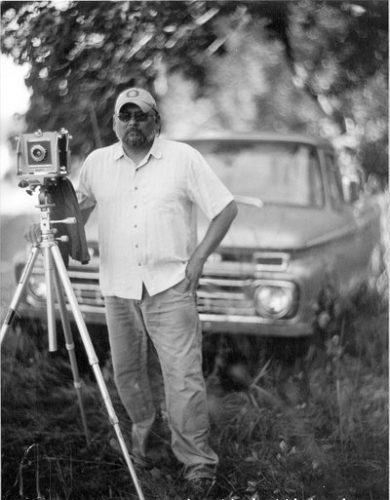
Since leaving the Navajo Nation at 18 to join the U.S. Army as a young man, Eugene visual artist Lemuel Charley has both nurtured his native roots and honored his brothers in arms, fueling unique insights and ambitions.
Charley draws from these two worlds — his native and military background — and in the photography and digital art he crafts, one sees life and love and light, though an unmistakable burden lies beneath. One animated print explodes with agitated lines, saturated colors and angular protrusions — all vanguard to a wall of deep earth tones. “A lot of it is quite chaotic,” he says.
Some of Charley’s work contains concrete symbology, lending itself to gift-shop connotations for the uninitiated. “There’s the traditional Native art that’s going to give people a fuzzy feeling like, ‘Oh, this is Indian art,’” he says, “and then there’s the contemporary side where you’re pushing buttons, making people think.”
Charley seeks out community art shows dealing with race and identity, unrecognized minorities and economic-environmental disparities therein. His work is currently on view for the show “All My Relations” through January at the University of Oregon Many Nations Longhouse.
“To me that image has always been very strong,” says friend and colleague Jessica Rojas, whose favorite Charley photo is of a uranium mining operation in Navajo country. Charley, 44, earned a digital arts degree from the University of Oregon in 2010 and previously was exposed to the art world while working for the Institute of American Indian Arts Museum in Santa Fe.
“What is Native art?” Charley asks. “Is it the art of Natives? Or is it art produced by Natives?” Something of a local authority on the subject, Charley says there is semantic evolution with each generation, but preservation of even the undefined is paramount.
“I see him as a leader and a ground breaker,” Rojas says. “It makes a lot of sense that I would look to someone who is Navajo and has a strong link to his culture.” She and Charley were introduced through the Northwest Indigenous Film Festival at Lane Community College. The two bonded as nontraditional students and through their indigenous identities. Rojas, 38, grew up among the Native community in Portland. “I identify as Chicana,” she says, “but I’m also Kumiai” — a people native to southern California.
Charley’s journey to Eugene began in 1998 with drinking buddies at Fort Bragg in North Carolina, “in my less serious days.” One toss of a dart sealed his fate as it struck Oregon on a map board in a strangely binding agreement.
 |
| Part of Charley’s ‘Welcome Come On In’ series on view now at the UO Many Nations Longhouse. |
His visual art never directly represents the wars in which he fought, but Charley has participated in The Telling Project, a veterans’ “witness theater,” which he has performed in Eugene, Seattle and Washington, D.C. In the 82nd Airborne Division, Charley served in the Persian Gulf, Haiti and Bosnia. “Those three invasions made me question my own humanity,” he says, “and U.S. foreign policy.”
Still, Charley continues to serve in the Oregon Army National Guard.
His life has come in dichotomies and cycles. “With destruction comes creation,” says Charley, who underwent extensive demolitions training in the Army. “There are times where I do work and just destroy it to start over again. In my mind, it’s the same process at different stages.”
See Charley’s work through the end of January at the UO Many Nations Longhouse. Charley’s work is also featured in the recently opened yearlong exhibit Ancestral Homelands Connection to Land, Space and Time at Anasazi Heritage Center in Dolores, Colorado. To see his work online, visit http://wkly.ws/1ut.